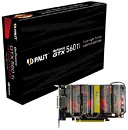Wednesday, October 12th 2011

Palit Shows Off GeForce GTX 560 Ti Twin Light Turbo Graphics Card
Palit unveiled a new limited-edition GeForce GTX 560 Ti based non-reference design graphics card, the Palit GTX 560 Ti Twin Light Turbo. The card's design is based on a black colored PCB (Palit uses a red-colored one on its regular GTX 560 Ti cards), and a unique GPU Cooler design. The heatsink follows essentially the same structure as the one featured on Gainward Phantom cards, in which heat is conveyed to the aluminum fin stack by four heat pipes, but the fans that ventilate the card are located on the side of the heatsink facing the PCB, rather than on top of it. The fans draw in air from the heatsink. Palit claims that the cooler has a noise output of less than 10 dBA.
The clock speeds of the card are not given out, yet. Like every other GTX 560 Ti, this card makes use of a 40 nm GeForce Fermi 114 GPU, is DirectX 11 compliant, packs 384 CUDA cores, and makes use of 1 GB of GDDR5 memory across a 256-bit wide memory interface. Display outputs include two DVI, and one each of D-Sub and HDMI (full-size). There is one SLI connector that allows 2-way SLI with any other GTX 560 Ti card, and power is drawn in from two 6-pin PCIe power connectors. Availability and pricing information is not known at the moment.
Source:
TechConnect Magazine
The clock speeds of the card are not given out, yet. Like every other GTX 560 Ti, this card makes use of a 40 nm GeForce Fermi 114 GPU, is DirectX 11 compliant, packs 384 CUDA cores, and makes use of 1 GB of GDDR5 memory across a 256-bit wide memory interface. Display outputs include two DVI, and one each of D-Sub and HDMI (full-size). There is one SLI connector that allows 2-way SLI with any other GTX 560 Ti card, and power is drawn in from two 6-pin PCIe power connectors. Availability and pricing information is not known at the moment.

11 Comments on Palit Shows Off GeForce GTX 560 Ti Twin Light Turbo Graphics Card
How does it work out to be cooler? Well fans mounted on the heatsink push a lot of air that spills and causes wind resistance/turbulence on the face of the fins and the card. I guess 50% of the air pushed by the fans is bounced rather than actually making it through the fin cooling structure. This makes noise.
In this setup, the only air that moves is the air that made it through the fins and therefore there will be a lot less noise due to turbulence.
This will be a winner for noise. It might not OC as high though. But if you run at stock, this will be a better setup IMO.
cool
Try running a fan and put your fingers near the intake and the airflow would be greatly reduced.